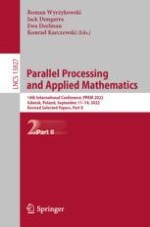This two-volume set, LNCS 13826 and LNCS 13827, constitutes the proceedings of the 14th International Conference on Parallel Processing and Applied Mathematics, PPAM 2022, held in Gdansk, Poland, in September 2022.
The 77 regular papers presented in these volumes were selected from 132 submissions. For regular tracks of the conference, 33 papers were selected from 62 submissions.
The papers were organized in topical sections named as follows:
Part I: numerical algorithms and parallel scientific computing; parallel non-numerical algorithms; GPU computing; performance analysis and prediction in HPC systems; scheduling for parallel computing; environments and frameworks for parallel/cloud computing; applications of parallel and distributed computing; soft computing with applications and special session on parallel EVD/SVD and its application in matrix computations.
Part II: 9th Workshop on Language-Based Parallel Programming (WLPP 2022); 6th Workshop on Models, Algorithms and Methodologies for Hybrid Parallelism in New HPC Systems (MAMHYP 2022); first workshop on quantum computing and communication; First Workshop on Applications of Machine Learning and Artificial Intelligence in High Performance Computing (WAML 2022); 4th workshop on applied high performance numerical algorithms for PDEs; 5th minisymposium on HPC applications in physical sciences; 8th minisymposium on high performance computing interval methods; 7th workshop on complex collective systems.
